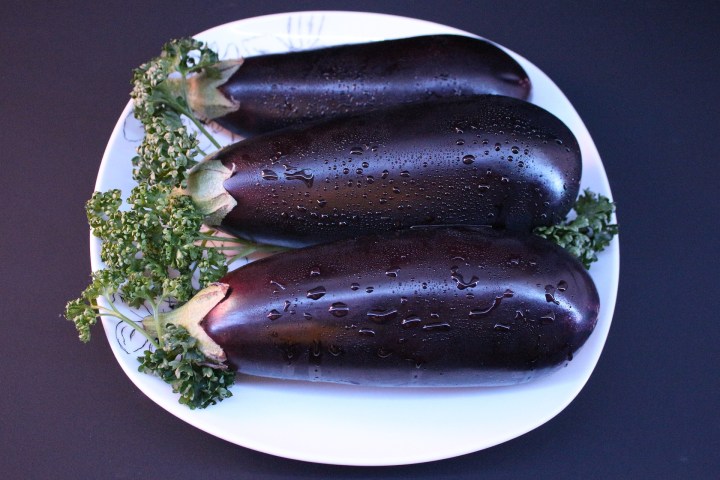MAIN INGREDIENT
All a brinjal needs is love, yeah yeah yeah

Black barbetane. Mad apple. Garden egg. Guinea squash. Call it what you will, it’s time to give the brinjal some love and affection.
See Tony Jackman’s recipe for Umami Moussaka here
The French, British, Irish and Québecoise call them aubergines, Americans and Australians call them eggplant, because older species were white and egg-shaped. Brinjal, the name, in fact derives from India, as does the fruit itself, but somehow it has stuck in South Africa, perhaps thanks to our large Indian community. I like the Italian name for it: melanzane. And, of course, it is the hero of a meaty Greek moussaka. About which more later.
The variety we eat in South Africa is generally the black barbetane, though the purple and white striped variety is sometimes found; I have some growing in my garden as it happens. The diminutive black ones you sometimes see at Woolies are called simply “baby”, while other varieties include white egg, yellow egg, long purple, green apple and pea, which are tiny, round and green, hence the name. And, of course, the more colloquial names I listed above.
Call them what you will, to me brinjals are like the world as seen by Lennon & McCartney. All they need is love and garlic, olive oil and onion, tomato and cumin; perhaps a dash of lemon. Welcome brinjals to the party, bring them into the fold, give them a hug or at least an elbow-bump and they’ll be your friend forever. They just need a bit of human understanding.
Who would be a brinjal. Ignored in the vegetable aisles while shoppers fuss around the tomatoes and carrots, popping bunches of celery, spinach and even leeks into their trolleys and scarcely giving the eggplant a second glance. Except for Those In The Know. Maligned as “other”, or at best as difficult and hard to comprehend, the brinjal is not, did I mention, all that popular in Little Britain, where garlic and “spice” mean anything not entirely bland. But enough about my ancestors. (Shirley Valentine may well have been a distant relative, off to Greece with her request for egg and chips, but I grew out of it.)
Brinjals are analogous, if you think about it, with Thai fish sauce. There’s nothing to recommend them in their raw state. They’re not like a tomato, a cucumber or a carrot, great to crunch into unadorned. They don’t smell remotely appetising, nor is their inner texture appealing to the eye or tongue. Take a bite of a raw eggplant and you’ll curl your lips in disgust; just as the nose revulses when sniffing the seemingly repugnant fish sauce. But cook with brinjals, or with fish sauce, and suddenly things make sense. Wonderful things happen in the pan or the pot.
Brinjals are grand looking on the outside, like the façade of a beautiful ancient building which has been gutted within; the only remnant of its original beauty its proud streetwise aspect. The Blue Mosque in Istanbul, perhaps, where, I fancy, an Imam once fainted. And it surprises me how few people seem to love this fruit masquerading as a vegetable. Aubergines marry with most things Mediterranean, from west to east and on both long shores of the Med. It is a darling of the North African kitchen as much as it is beloved from Spain to Turkey via Italy and Greece.
That old tradition of slicing up an aubergine, salting it in layers and leaving them for half an hour for the bitter juices to run out, then rinsing them, is considered no longer necessary as modern commercial varieties are no longer as bitter. But I still do it. I’m sure I can taste the difference.
The most famous eggplant recipe is Imam Bayildi (the Imam fainted), a traditional Turkish dish of the vegetable (okay, fruit) stuffed with tomato, onion, garlic, herbs and spices. A close contender has to be Italy’s melanzane parmigiana, a baked dish of brinjal slices with a homemade rich tomato sauce and cheese, though a variation of this sees the tomato and cheese rolled up. Then there’s Australia’s (and elsewhere’s) beloved “Chicken Parma”, in which the brinjals are chucked out altogether and replaced with chicken.
Coming in a not too distant third would be baba ghannouj (a.k.a. ghanoush/ ganoush), a delicious Levantine appetiser incorporating blended, cooked aubergine with garlic, tahini (ground sesame dip), cumin and lemon, or variations thereof.
But what would moussaka be without brinjal. Which I make often. But, Greek readers please look away now, because this week I made a variation that I called Umami Moussaka, making bacon a key ingredient alongside brinjal. One of those experiments about which you wonder, hmmm, will it work… And then you give it a go…
And now you think: hell, why didn’t I think of that before? So here’s the recipe… DM/TGIFood





Comments - Please login in order to comment.